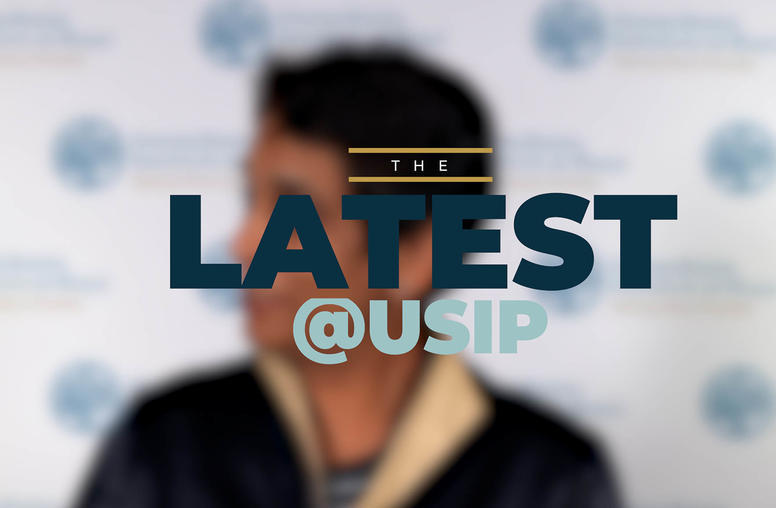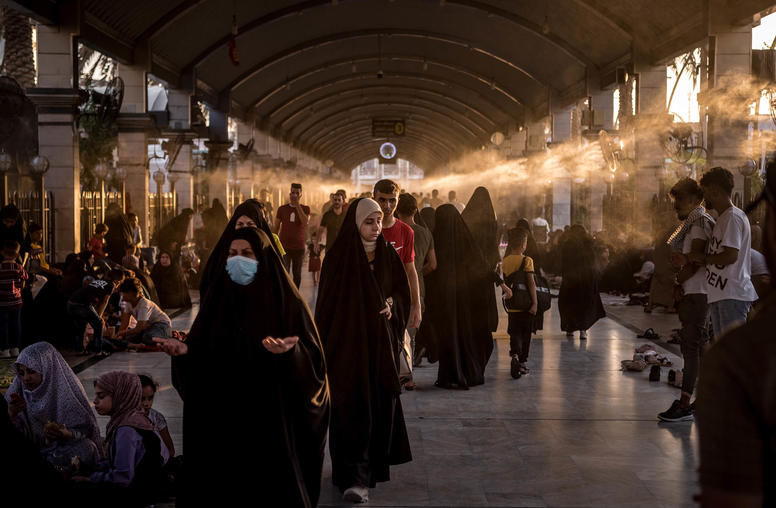Amid COVID, We Need Enhanced International Coordination to Build Peace
Tackling the pandemic and building resilience in fragile states requires concerted international action at local, national, and global levels.
Editor’s Note: This article is the first in a series that summarizes the Conflict Prevention and Fragility Working Group’s discussions on implementation of the Global Fragility Act.
As the humanitarian and economic toll of the COVID-19 pandemic continues to grow, so does the risk that this crisis will fuel new conflicts around the world, while stymying prospects for resolving ongoing ones. The global health crisis is triggering devastating levels of food insecurity and unemployment, especially in the world’s most fragile states, where the social contract between citizens and the state is severed and societies are fragmented and vulnerable to violence. These trends will almost certainly lead to a future spike in instability across these countries, unless concerted international action is taken.

With the global multilateral system under strain, it is unclear if a unified global effort is possible. Heeding the U.N. secretary-general’s call, the Security Council this month passed a resolution calling for a global cease-fire in response to the pandemic. The U.N. also has a global humanitarian response plan in place to address both the health crisis and some of its secondary impacts on livelihoods and stability. But member states adopted the resolution after significant delays, sending a signal of their lack of resolve to take concerted action. And with funding for international development dropping relative to the same period last year, the failure of member states to substantially fund the U.N.’s response plan further demonstrates the current lack of commitment to unified action at the global level.
Building effective international coalitions on the ground in fragile states is important, given that conflict drivers are context-specific, and this will be especially important in the absence of concerted action at the global level. To advance the recently adopted Global Fragility Act (GFA), country coordination platforms—consisting of a forum for sustained policy dialogue between international partners, host governments, and civil society actors—should be built, or strengthened in countries where they already exist, to prevent conflict and build resilience to the destabilizing shocks that can spark future violence.
Evidence and Joint Accountability
Promoting effective cooperation in fragile states is an age-old challenge. As the development and humanitarian community has learned for well over a decade, coordination is key to avoiding inefficient or wasteful aid allocations or overwhelming weak host-government institutions. Before the pandemic hit, the GFA already called on the U.S. government to “identify mechanisms to improve coordination between the United States, foreign governments, and international organizations” to better address the causes of fragility and violence. Recent lessons suggest that achieving closer coordination on the ground in developing countries requires putting in place two sets of mechanisms, which should either be established or strengthened.
The first is a framework for conducting joint-needs assessments and plans for preventing conflict and building resilience, a practice that has become more common in the development sector in the aftermath of conflict, and increasingly even in countries where conflict is only beginning to spread. To have sustainable impact, joint assessments should take place under the leadership of the host government—with U.N. and World Bank country teams providing strong support—and should be inclusive not only of national and local government representatives, but of the civil society actors that need to help drive the policy agenda. The assessment and planning phase should include a strategic-level, joint framework for evaluating progress toward policy objectives and holding the parties to account. That process should be enshrined in a diplomatic agreement. The methodology for the joint assessment must balance depth and analysis with speed—the assessment and analysis phase must not be overwhelmed by the speed of the conflict or miss important opportunities to build peace.
Organizing for Collective Action
Equally important but often under-appreciated is the need to establish a robust cooperation structure—or country coordination platform—to guide the implementation of these joint assessments and the strategies they produce, and to oversee their implementation on the ground. While the need for evidence-based conflict assessments, robust strategies, and clear metrics for tracking progress are widely appreciated in the peacebuilding community, far less attention has been given to the country-based organizational structures and processes that are needed to develop coordination, strategic planning, and mutual accountability over time to achieve results. This lack of attention is surprising given the significant investments donors make in fragile states.
Despite billions of dollars spent in some countries over recent years, there has been alarmingly little attention given to developing the institutional architecture that is needed to implement plans and target funds in ways that are strategic, sustainable, and aligned with national priorities.
Designing Country Coordination Structures to Advance the GFA
Based on the extensive research one of these authors has undertaken on these platforms, below is a set of criteria for designing effective country coordination structures.
Successful platforms share an underlying three-part model:
- A high-level steering group: This body should be led by the host-country’s president or prime minister and include bilateral donors, multilateral institutions, and representatives from implementing partners and civil society. Ministerial-level participation in a high-level steering group is necessary to ensure this body can perform its policy planning and oversight functions, and to ensure that the initial joint strategy remains responsive to changing conditions on the ground, which might require a strategic shift. Successful platforms, like the one established in Liberia after that country’s brutal civil war and in Rwanda following the 1994 genocide, include high-level representation—their policy planning and oversight functions cannot be accomplished through expert-level international working groups. Representation by national civil society helps to foster national ownership over the process at the highest level, while the inclusion of operational partners helps to deepen insights on implementation challenges and possible solutions. A high-level international compact can help this body monitor and advance shared responsibilities and foster greater cohesion among stakeholders in performing oversight functions based on agreed priorities.
- Sector groups: Led by government ministry representatives, sector groups include a broad range of stakeholders who are responsible for shaping policy across development sectors that are relevant to conflict prevention—such as basic services, the economy, security sector reform, governance, rule of law, and infrastructure. In many countries, including Haiti and Timor-Leste, a sector group was not initially established as part of the aid architecture. In both countries, this led to dysfunction as ministry-level interlocutors and their international counterparts were excluded and unable to vet or coordinate sector-specific proposals that were submitted to the committee charged with monitoring the progress of implementation.
- A secretariat: Due to the limited capacity of governments in fragile states, ensuring the smooth operations of both the high-level and sector groups requires a dedicated support structure. Often led by the host-country’s ministry of planning, this body can provide critical capacity support, enabling the country platform to function by collating data from host-government institutions and international partners.
Country coordination platforms organize national and international stakeholders into a three-tiered structure that allows them to align their activities, including potentially large-scale operations and pools of funding. Such joint arrangements are necessary to promote adaptive management of programs—allowing stakeholders to work together to adapt to rapidly evolving conditions and longer-term trends.
Critically, these platforms must not serve as top-down mechanisms for imposing externally determined policy prescriptions. Instead, they must actively incorporate feedback from local stakeholders and adapt policies and programs in the face of shocks and complex political economies. The GFA’s most important directive is arguably that the U.S. government adopt an adaptive management approach to prevention, peacebuilding, and development. Peace processes and programs have too often been designed based on externally imposed timelines and goals, as was the case in South Sudan where donors and the central government imposed a largely top-down approach that was not inclusive of local and civil society actors and failed to promote peace in that country.
In Somalia, the three-tiered model described above has been time-tested and helped to sustain peace efforts over the past decade.
The Case of Somalia
Somalia’s country platform is a leading example of how these mechanisms can provide a center of gravity for collective action, even under extremely difficult operating conditions in a war-torn country. (One of these authors served as the director of USAID’s Somalia field office.) Recent analysis and assessments have shown how pivotal Somalia’s coordination platform has been to advancing the country’s incremental progress, and preventing that country’s slide back into full-blown civil war. This country coordination architecture has increased the transparency and predictability of development investments, forged greater coherence among Somalia’s international partners, and assisted the development of major political and economic benchmarks, including the formation of federal member states and progress toward debt relief. Although the Somali government initially led this platform from a position of weakness relative to donors, the platform has helped to enable government leadership to formulate more effective policy and direct funding more strategically toward the political, security, and development pillars.
While Somalia’s country coordination platform is widely hailed as a success, its implementation was not without challenges. These include a mismatch of high expectations and slow implementation at the outset, insufficient engagement with representative civil society organizations and citizen groups throughout the assessment and implementation stages, and insufficient efforts to integrate the security sector. Learning the lessons from Somalia’s experience—while replicating features of the model that worked effectively—may prove helpful in other fragile contexts.
Ultimately, country coordination platforms present a promising entry point for U.S. policy to rally conflict prevention efforts in fragile states in the absence of concerted action at the global level. The time is ripe for the United States to lead and invest in effective country platforms to prevent conflict, stabilize war-torn societies, and support countries on their journey to self-reliance.
Jonathan Papoulidis is World Vision’s executive advisor on fragile states.



